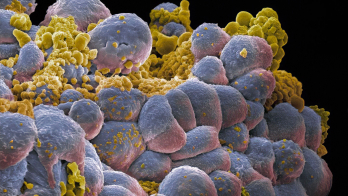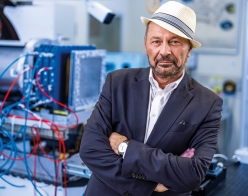
Image credit: JINR.
The successful completion of the upgrade to the Nuclotron at JINR marks the end of an important first step in the construction of the Nuclotron-based Ion Collider Facility and Multi-Purpose Detector (NICA/MPD) project. NICA, which is JINR’s future flagship facility in high-energy physics, will allow the study of heavy-ion collisions both in fixed-target experiments and in collider experiments with 197Au79+ ions at a centre-of mass energy of 4–11 GeV (1–4.5 GeV/u ion kinetic energy) and an average luminosity of 1027 cm−2 s−1. Other goals include polarized-beam collisions and applied research.
NICA’s main element is the Nuclotron, a 251 m circumference superconducting synchrotron for accelerating nuclei and multi-charged heavy ions, which started up in 1993. It currently delivers ion beams for experiments at internal targets and has a slow extraction system for fixed-target experiments. By 2007, it was accelerating proton beams to 5.7 GeV, deuterons to 3.8 GeV/u and nuclei (Li, F, C, N, Ar, Fe ) to 2.2 GeV/u.
The Nuclotron upgrade – the Nuclotron-M project – was a key part of the first phase of construction work for NICA. It included work to develop the existing accelerator complex for the generation of relativistic ion-beams with atomic masses from protons to gold and uranium, at energies corresponding to the maximum design magnetic field of 20 T. The goals were to reach a new level in beam parameters and to improve substantially the reliability and efficiency of accelerator operation and renovate or replace some of the equipment.
The Nuclotron facility includes a cryogenic supply system with two helium refrigerators, as well as infrastructure for the storage and circulation of helium liquid and gas. The injection complex consists of a high-voltage pre-injector with a 7000 kV pulsed transformer and an Alvarez-type linac, LU-20, which accelerates ions of Z/A ≥0 0.33 up to an energy 50 MeV/u. The wide variety of ion types is provided by a heavy-ion source, ESIS “KRION-2”, a duoplasmatron, a polarized deuteron source, POLARIS, and a laser ion-source for light ions.
As a key element of the NICA collider injection chain, the Nuclotron has to accelerate a single bunch of fully stripped heavy ions (U92+, Pb82+ or Au79+) from 0.6–4.5 GeV/u with a bunch intensity of about 1–1.5 × 109 ions. The particle losses during acceleration must not exceed 10% and the magnetic field should ramp at 1 T/s. To demonstrate the capacity of the Nuclotron complex and satisfy these requirements, the general milestones of the Nuclotron-M project were specified as the acceleration of heavy ions (at atomic numbers larger than 100) and stable and safe operation at 2 T of the dipole magnets.
The upgrade, which started in 2007, involved the modernization of almost all of the Nuclotron systems, with time in six beam runs devoted to testing newly installed equipment. Two stages of the ring vacuum system were upgraded and cryogenic power was doubled. A new power supply for the electrostatic septum of the slow extraction system was constructed and tested, and new power supplies for the closed-orbit corrector magnets were also designed and tested at the ring. The ring’s RF system was upgraded to increase the RF voltage and for tests of adiabatic trapping of particles into the acceleration mode. Vacuum conditions at the Nuclotron’s injector were improved to increase the acceleration efficiency. A completely new power-supply system as well as a quench protection system for magnets and magnetic lenses were also constructed, including: new main power supply units; a new power supply unit for current decrease in the quadrupole lenses; 10 km of new cable lines; and 2000 new quench detectors. In parallel, there was also progress in the design and construction of new heavy-ion and polarized light-ion sources.
Following the Nuclotron’s modernization, in March 2010 124Xe42+ ions were accelerated to about 1.5 GeV/u and slow extraction of the beam at 1 GeV/u was used for experiments. In December, the stable and safe operation of the magnetic system was achieved with a main field of 2 T. During the run the power supply and the quench protection systems were tested in cycles with the bending field of 1.4, 1.6, 1.8 and 2 T at the plateau. The field ramped at 0.6 T/s and the active time for each cycle was about 7s. A few tens of the energy evacuation events were acquired; in all of them the process was in the nominal regime.
In parallel with the upgrade work, the technical design was prepared for elements in the collider injection chain (a new heavy-ion linear accelerator, booster synchrotron and LU-20 upgrade programme). In addition, the technical design for the collider is in the final stage. The dipole and quadrupole magnets for the collider, as well as for the booster, are based on the design of the Nuclotron superconducting magnets. These have a cold-iron window-frame yoke and low-inductance winding made of a hollow composite superconductor; the magnetic-field distribution is formed by the iron yoke. The fabrication of these magnets gave JINR staff a great deal of experience in superconducting magnet design and manufacturing.
The prototype dipole magnet for the NICA booster was made in 2010 and construction of the magnet model for the collider, based on the preliminary design, is in the final stage. To construct the booster and collider rings, JINR needs to manufacture more than 200 dipole magnets and lenses during a short time period. The working area for magnet production and test benches for the magnet commissioning are currently being prepared.








